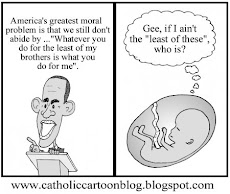I just read Stanley Kurtz' new book Radical-in-Chief: Barack Obama and the Untold Story of American Socialism (Simon & Schuster, 2010). It is an original work of scholarship dependent, almost entirely on archival work, which examines the background of Barack Obama and the circles in which he moved from adolescence through college, work, law school and community organizing. It is a fascinating and illuminating window into the world of left wing activism.
Those who have read David Horowitz' Destructive Generation or A Radical Son, or other books on the rise of the New Left in the 60s, may well ask the question: "Where did the radical, communist activists of the SDS, the Weathermen and other strands of New Left agitation go after the 70s? The so-called "long sixties" extend from the mid-fifties the mid-seventies and slowly burn out with the end of the Vietnam War and the Cambodian genocide. With the election of Ronald Reagan in 1980, the US took a definite rightward turn, but what happened to New Leftists who came of age in the 60s?
Of course, some of the less ideological campus radicals traded in their beads and long hair for suits and BMWs. They moved seamlessly from pot and "free love" to being stock brokers and lawyers. They maintained a bohemian ethic in their personal lives and combined it with a meek submission to the capitalist system, which they simultaneously despised and profited from.
But what about the the real communist ideologues? What about the violent revolutionaries who were true believers in the Revolution? What about the hard core radicals who manipulated the less politically aware masses for socialist ends? Where did they go? Did they "sell out" too? Did they maintain their Marxist ideology? Did they continue to work in an organized fashion? Did they change their goals? These are the questions this book provides solid, documented answers for and the answers are surprising and worthy of serious consideration by anyone convinced that socialism is dead in America.
The fact that the New Left (the anti-Stalinist but often pro-Mao Marxist-Leninist movement that arose after Khrushchev unveiled the crimes of Stalin and thus damaged the "brand" fatally) continued to exist after the 1970s may surprise some naive people. I find that many apolitical Evangelicals are extremely naive about the actual threat to Western freedom that continues to exist in the form of Marxism. A giant cultural myth has been erected as a kind of protective shield for Marxism that consists of the following three themes, which are hammered home relentlessly: (1) anyone who fears Marxism is a witch-hunting, fanatical, right-wing ideologue using McCarthism to persecute innocent individuals and (2) we have nothing to fear from Marxism or socialism because neither has anything to do with Stalinism and (3) although socialism does not work as an alternative to capitalism, its critique of capitalism is still valid. Behind the shield created by these three themes, the New Left continues to work for the Revolution by indirect and subversive, rather than by open and violent means.
The New Left ideologues did not lose their ideology; nor did they give up their revolutionary ideals. But they did shift their strategy in major ways. In fact, I would go so far as to say that a new type of socialism has emerged since 1980 which has three distinctive characteristics: (1) it is a movement from below which does not seek government control of the means of production (i.e. nationalization of all heavy industry), but rather seeks to control industry and commerce from below by grass roots pressure on corporations, (2) it is a movement that does not focus on economics directly, but on education, environmentalism and social welfare programs and (3) it is a movement that seeks to expand dependency on the state in every way possible by dislodging individuals from the influence of families, churches and other forms of civil society and making them directly dependent on the state. Sex education that promotes pansexualism in public schools would be an example of this strategy.
These New Left ideologues no longer make bombs in basements, but work through foundations and environmental groups to influence society incrementally rather than transform it over night. Obviously, this approach was dictated, to a certain extent, by the popular triumph of conservative political and economic thought at the national level during the Reagan years. Only the "perfect storm" created by the economic downturn, the unpopularity of the Iraq War, and the disillusionment of Bush's conservative base with his big-spending approach opened the door to a return of big-spending, big-government leftism in 2008. The question Kurtz' book answers is what Obama was doing between the 80s and 2006 and what that means for a proper understanding of his own personal political convictions and goals.
The short answer is that Obama was a community organizer, which places him in the center of the New Left strategy for working to implement socialist and statist ideals from below without focusing on the economy, but on grass roots pressure upward for social transformation. The community organizer is not the old-fashioned communist agitator who is trying to recruit members for the Party; the community organizer is not focused on the Party at all. An informal network of allegiances has replaced top-down party discipline. The network is what this book describes: socialist conferences in New York City, black liberation theology in the churches, the Midwest Foundation, ACORN, community organizer training seminars and so on.
Much of the cost of socialist agitation in today's America is borne by the taxpayer. It is ironic that community organizers have mastered the art of getting government grants to fund projects that supposedly help the community, but which actually provide salaries for workers seeking to advance their leftist ideology. ACORN is the prototypical example of such an organization.
Kurtz documents Obama's close working relationship with unrepentant communist Bill Ayers, Cuba-loving, America-hating Jeremiah Wright, and ACORN and uncovers the web of lies spun to protect Obama's true ideology and keep it hidden from the public. Since the 80s it has been standard operating procedure to keep the depth of Marxist ideology that motivates the activists well below the surface. Community organizing sounds harmless to the average apolitical voter and that same average voter is unlikely to detect any connection between environmentalism and socialism. Of course, the mainstream media, shaped in a socialist worldview by their university education, will not tell them. So the socialism is hidden in plain view. It is not discerned by the average person but for the trained researcher who knows what to look for it is as obvious as the sun.
This book performs a real service to anyone who desires to understand the continuing battle within Western culture between the forces of that greatest of all Christian heresies, Marxism, and traditional, conservative, Christian liberal political thought. We can now say with confidence that Barack Obama wants to transform America into (at least) a social democracy and that his socialist goals are integral to his worldview, his life work and his personality. For that, we are in Stanley Kurtz's debt. Thanks to this book what many people suspected is not documented fact.
UPDATE: You can see Peter Robinson interviewing Stanley Kurtz about his book on Uncommon Knowledge here. Just scroll down to Feb. 4-8. The interview is in 5 parts.
Subscribe to:
Post Comments (Atom)





No comments:
Post a Comment